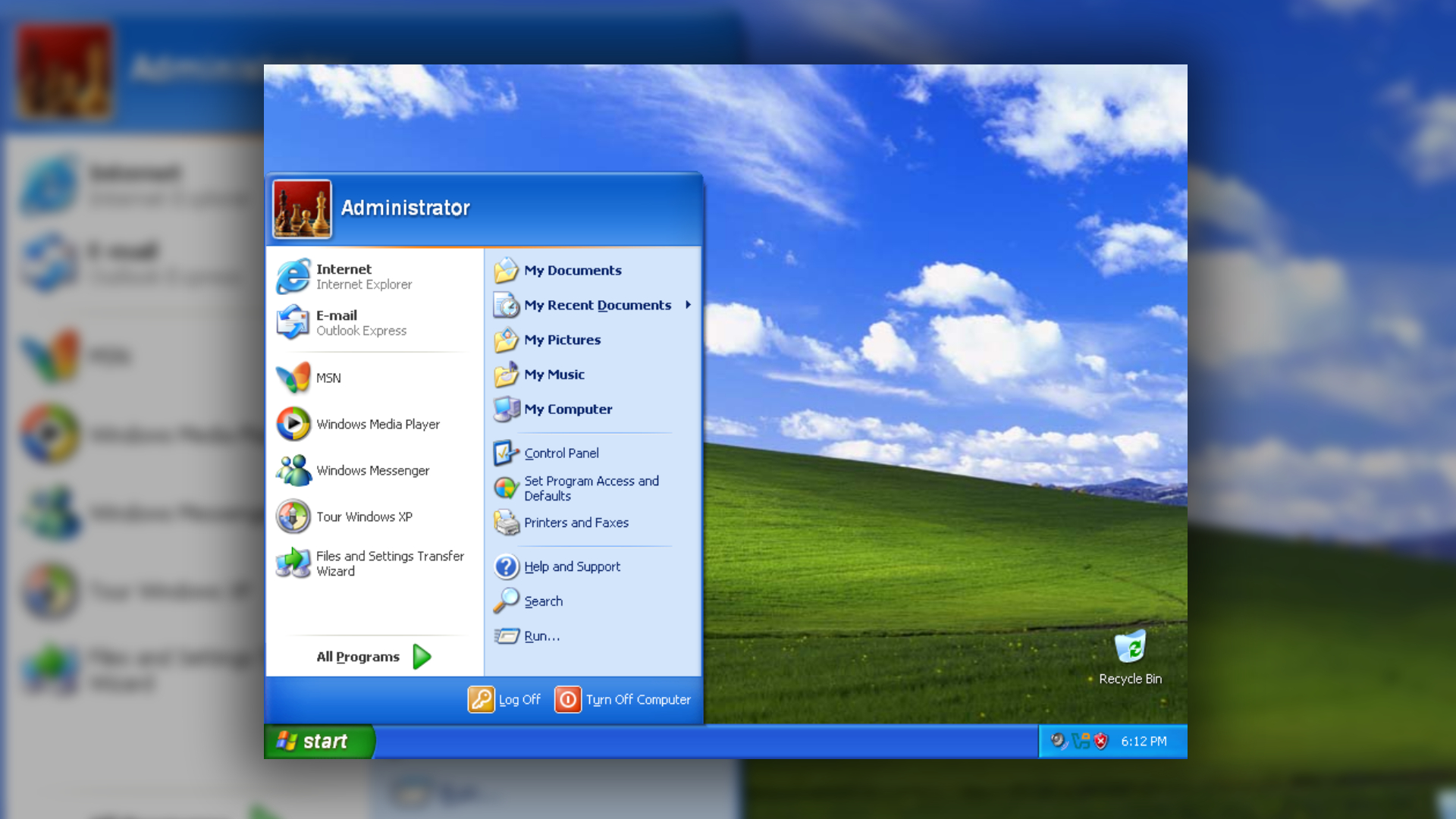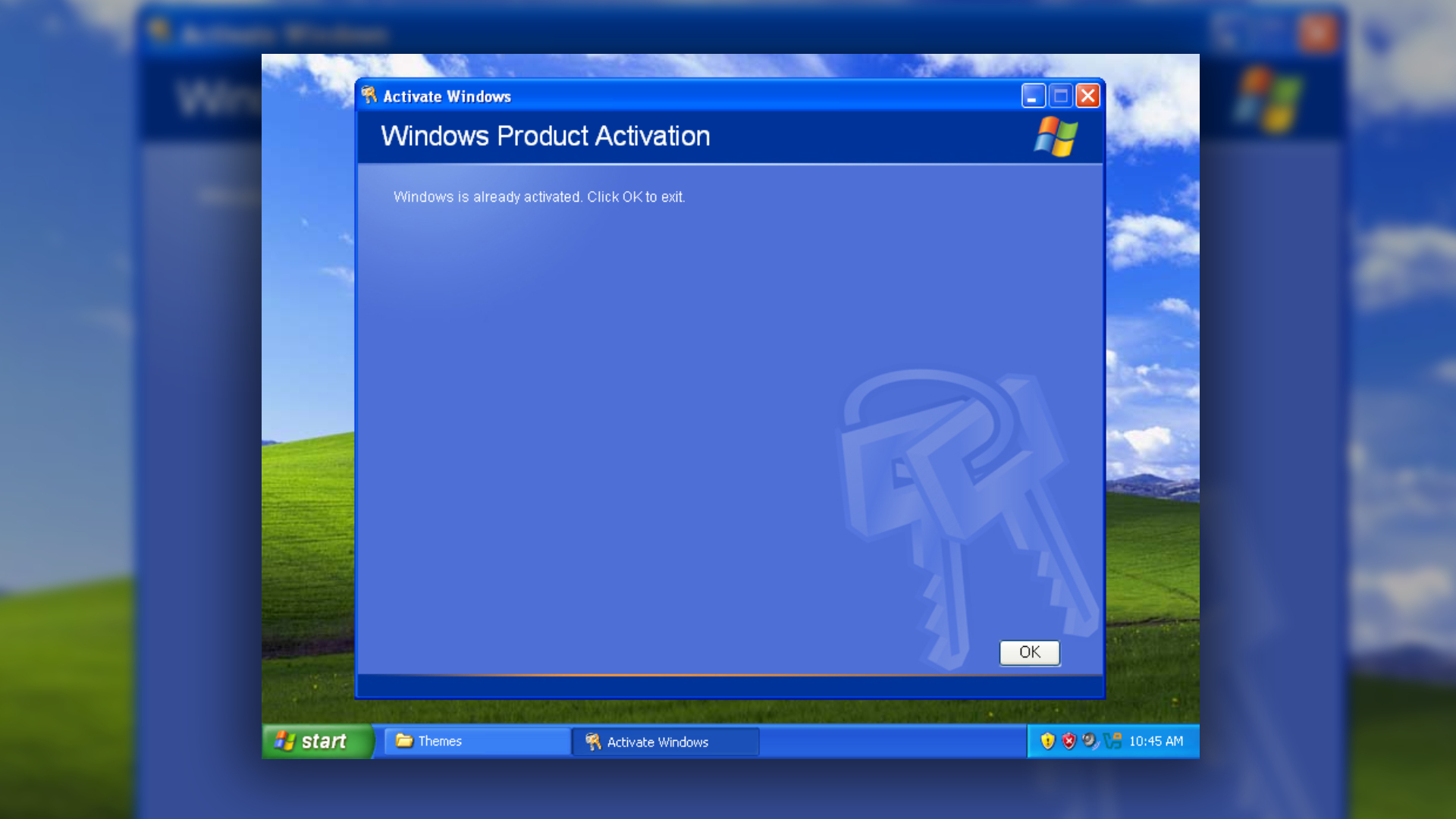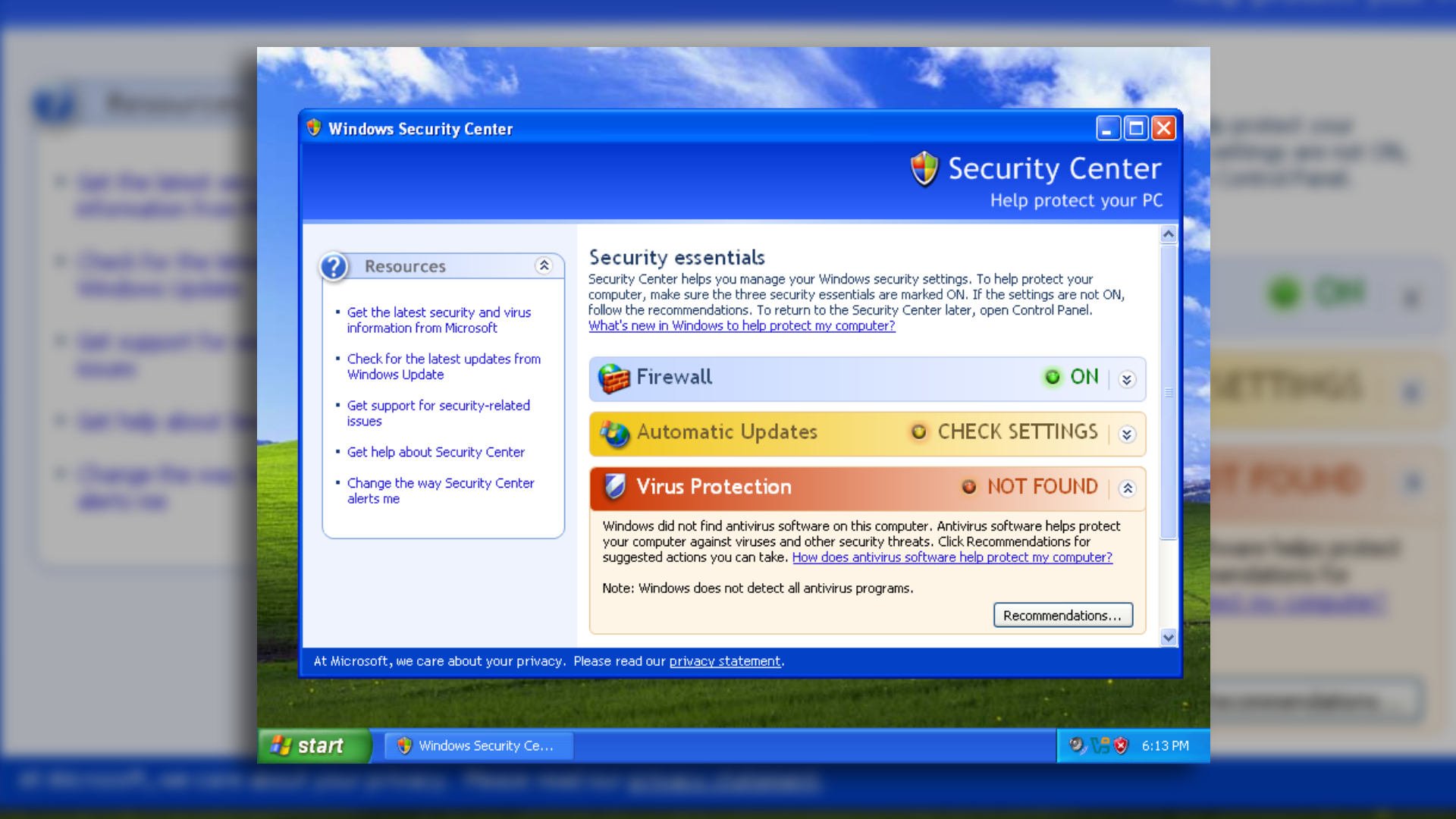40 years of Windows: How XP changed everything
The real "Start Me Up" moment

Microsoft released Windows XP in 2001 — and that was the moment Windows as an operating system matured. Beneath the divisive, colorful blue interface, the OS was now built on the stable Windows NT core, which was previously used for business operating systems.
The consumer and business Windows products merged: There was no more temptation to pirate a copy of Windows 2000 from work, rather than stick with Windows Me. Now, you could use a business-grade version of Windows at home. And while Windows XP had its problems, it was much more stable than Windows 98 or Windows Me.
Windows XP's release was the moment Windows truly became the modern operating system we use today. It set the stage for everything that's happened since. That's true for good and for bad: Windows XP was also the operating system that got slammed hard by malware out of the gate, forcing Microsoft to prioritize security and change the way the company builds software.
The Windows NT core
The original Windows operating systems — from the initial release of Windows 1.0 to Windows 3.1 and then on to Windows 95, Windows 98, and Windows Me — were based on Microsoft DOS under the hood.
This MS-DOS core caused many problems. Under the hood, Windows 9x was a pretty stone-age operating system, compared to other operating systems of the day, including IBM's OS/2, Linux, and other Unix-like operating systems.
A single badly behaved program could mess with other running apps or bring down the entire operating system. There was no ability to have multiple users or permissions, the FAT32 file system wasn't as good at recovering from crashes as the NTFS file system that came with Windows NT — an important point since the operating system could be so unstable — and so many other problems that couldn't be fixed without a total replacement of the underlying code.
The Windows 9x interface may have looked similar to Windows 2000, but underneath the hood, it was a mess of old DOS code and drivers.
In comparison, Microsoft's business-focused line of Windows operating systems was based on the Windows NT kernel. Hardware drivers caused fewer catastrophic problems, processes were isolated from each other so they couldn't take each other down, it was a multi-user operating system with permissions, and drivers were less likely to crash the whole system.
For consumers, Windows XP was a space-age upgrade from Windows 98 under the hood. But it wasn't just Windows 2000 in a new blue suit — Windows XP had so many other changes that even Windows 2000 users could appreciate (once they could look past that default blue "Luna" skin.)
The looks: Luna, Bliss, and Rover
Windows XP is now a widely beloved operating system that many people have happy memories of — and many people stuck with it for a long time, especially after Windows Vista launched. That's why it's funny to remember that many people's first reaction to the blue title bars and bright green start button: They called it a "Fisher-Price" interface. Or, in other words: A toy designed for children.
Of course, you could still swap over to the Classic theme in a few clicks. The search assistant — a dog named Rover that helped you search for files, which was initially part of the Microsoft Bob operating system — was also easily disabled in a few clicks.
The default desktop background — a scene of rolling green hills under a blue sky — is perhaps the most enduring visual artifact from the era of Windows XP. Named Bliss, the wallpaper was actually a real photograph taken in Napa, California.
The blue visual style was just one option, and there was also a sleek Silver option and an odd-looking Olive Green one. Beyond that, Microsoft provided downloadable visual styles: Royale was a brighter blue theme that originally shipped with Windows XP Media Center Edition. Years later, Microsoft offered a Zune theme with a black and orange design, designed to promote the company's iPod competitor.

Windows XP also kicked off the uxtheme.dll style craze. Windows XP was designed to only work with Microsoft-created themes, but with a quick hack, you could remove this protection and run user-created themes downloaded from sites like DeviantArt. It was the golden age of Windows desktop customization. Stardock's WindowBlinds is still around today, but it doesn't work as well on a modern Windows 11 desktop, where applications and other components are less customizable. On Windows XP, the entire interface was — and it's a shame we lost that.
Cutting-edge features
Windows XP wasn't just architectural changes under the hood — it was a better consumer operating system, too. So many important parts of Windows appeared for the first time.
System Restore made its debut in Windows Me, but it was buggy — in Windows XP, it worked well for rolling back driver problems. (I'll be honest, though: I had so many problems with System Restore on Windows Me that I never trusted it when I used Windows XP).
It just worked better with new hardware: USB plug-and-play support "just worked" when you plugged in devices, it had built-in CD burning software, and ClearType support improved readability on those fancy new LED displays that were replacing bulky old CRT monitors.

Windows XP could finally open ZIP files out of the box, too. You didn't need WinZip anymore — but you might have needed WinRAR. It took decades before Microsoft added support for more archive types — RAR support popped up in Windows 11 in 2023, 22 years later. But it was a good start.
And how can you forget Windows Movie Maker? Microsoft's consumer video editor was widely beloved and hugely iconic around the dawn of the YouTube era. While it wasn't included with the first version of Windows XP, which launched in 2001, it was added to Windows XP with Service Pack 1 in 2002.
The great piracy crackdown
Windows XP was the first time Microsoft took Windows piracy seriously, on a software level. Earlier operating systems like Windows 98, Windows Me, and Windows 2000 required a CD key during the installation process, but that was it. On a software level, everyone could use the same CD key.
Grabbed a copy of Windows 2000 from work? You could easily find a key that would work with it. And, after the installation, Windows would never double-check your CD key.
That changed with Windows XP, which introduced the idea of Windows Activation. In theory, a pirated version of Windows with a duplicated CD key couldn't activate. This set up a race between pirates and Microsoft. Windows could activate itself over the internet, but it would also prompt you to dial up a phone number if you didn't have an internet connection.

In 2005, Microsoft introduced Windows Genuine Advantage via Windows Update. It was designed to fight back against Windows pirates who had tricked the Windows Activation system — it would check your PC's activation status again, blocking pirated keys, nagging you with constant popups, and blocking you from accessing certain features. Things were a little messy at first, and Windows Genuine Advantage even bit some users with legitimate licenses.
Windows XP forced Microsoft to take security seriously
Windows XP was a real turning point for Windows security. Windows XP's security was an embarrassment when it was first released. The firewall was off by default, and services designed for secure corporate networks were sitting and listening to the internet out of the box.
Without a firewall enabled, and with no integrated antivirus software, early Windows XP systems connected directly to the internet were prone to dangerous worms like Blaster and Sasser. A fresh Windows XP system connected directly to the internet could be infected by the worm within minutes, without the PC's user doing anything at all.

Microsoft made changes with Windows XP Service Pack 2 in 2004. Windows XP finally had a firewall on by default to protect vulnerable services, complete with a Security Center that nagged people to install an antivirus. Windows didn't have a built-in antivirus until Windows 8, however.
Service Pack 2 also came with other security changes, including Data Execution Prevention to protect against certain types of exploits, and enhanced security for programs like Internet Explorer and Outlook.
In 2002, Bill Gates sent a "Trustworthy Computing" memo to the company. He wrote: "When we face a choice between adding features and resolving security issues, we need to choose security. Our products should emphasize security right out of the box." That's, of course, an admission that Windows XP's initial release was not exactly designed with security in mind — if it was, it would have had the firewall activated out of the box. Windows XP Service Pack 2 was the result of that shift, and it affected how all future versions of Windows were developed.
Windows XP became a difficult act to follow
Windows XP was pivotal in a cultural moment, where the internet exploded in popularity. And with it came numerous programs which many still use today. Mozilla Firefox, Google Chrome, Steam, and Skype were all huge programs that launched on Windows XP. Titans of the modern internet, such as YouTube and Facebook, were first mainly accessed on Windows XP PCs.
In an era where OS's were released incredibly regularly, Windows XP signalled a step change in that thinking. It matured and was iterated and improved upon. Windows XP eventually became stable, safe, and normalized. It wasn't a big deal that you had Windows XP; after a certain time, it was just Windows.
Soon after XP's release, Microsoft began work on Project Longhorn, which had all kinds of deep changes, including a new way to manage and store files named WinFS — a layer on top of the NTFS file system that captured metadata and relationships, instead of folders and file names. Microsoft promised it would still launch on Windows Vista, but eventually canceled it completely.
But Windows XP got slammed so hard by those worms that Microsoft developers were moved from Project Longhorn to work on Windows XP Service Pack 2. In 2004, Project Longhorn was scrapped, and Microsoft began work on the operating system that became Windows Vista, or (by the man's own admission), Steve Ballmer's biggest mistake.
Windows XP wasn't just an OS, it was a moment
Windows XP was special. It was the backdrop for so much of what happened on the early modern internet, and its eventual longevity made it legendary. I was eager to upgrade to Windows 7 — that's right, I was one of the people who skipped Windows Vista — but I was still a little sad to leave Windows XP behind.
You can still use it today — I booted it up in a virtual machine for this very retrospective. But it won't get security updates, doesn't run modern software, and its web browser can't even load modern websites. If you connect it to the internet, you might even get some of those infamous viruses. Aside from that, it's the same cozy old Windows XP we all knew and loved.
Or, if you want more Windows XP flair on your modern Windows 11 or Windows 10 PC, install RetroBar, where you can still capture some of that retro Windows XP flavor, but with a modern (and hopefully worm-free) OS.
Windows XP might be cast into the annals of operating systems long past, but it deserves to be remembered as a significant moment for Microsoft, with hard lessons learned, and changes that still affect modern versions we use today.

Chris Hoffman is a veteran tech journalist and the former Editor-in-Chief of How-To Geek. He's been writing about Windows, PCs, and other tech topics for 15 years. His work has also appeared in The New York Times, PCWorld, PCMag, Computerworld, Fast Company, and Reader's Digest.
